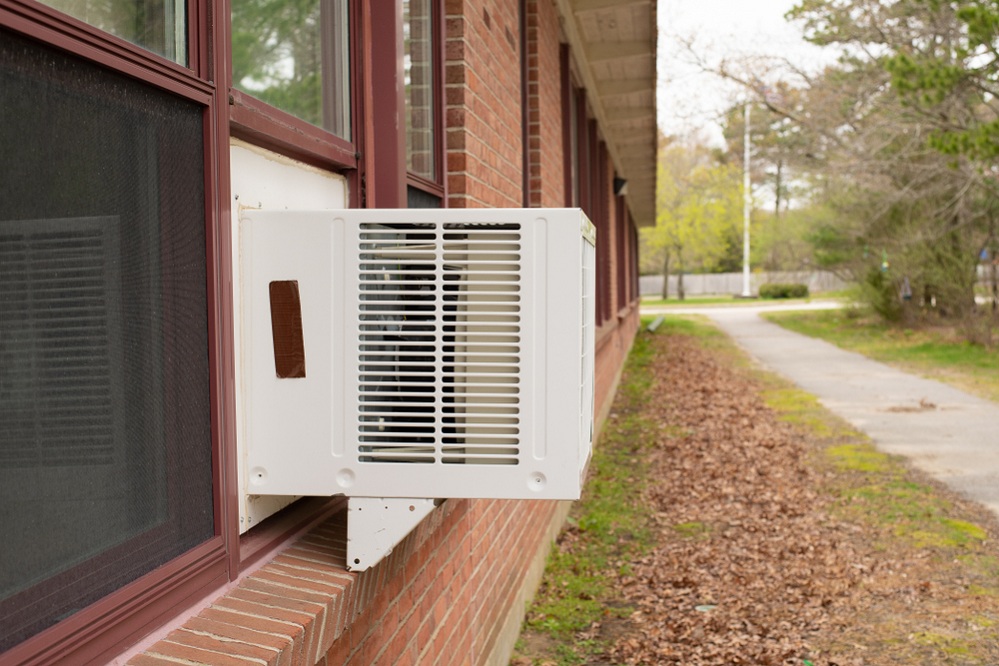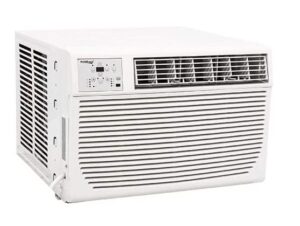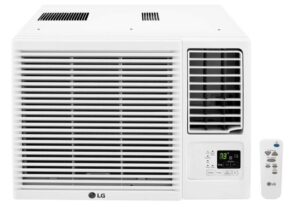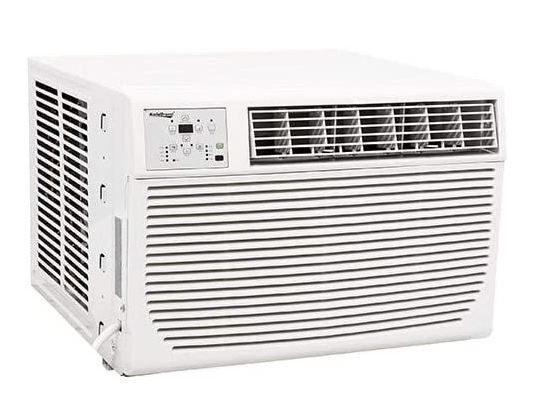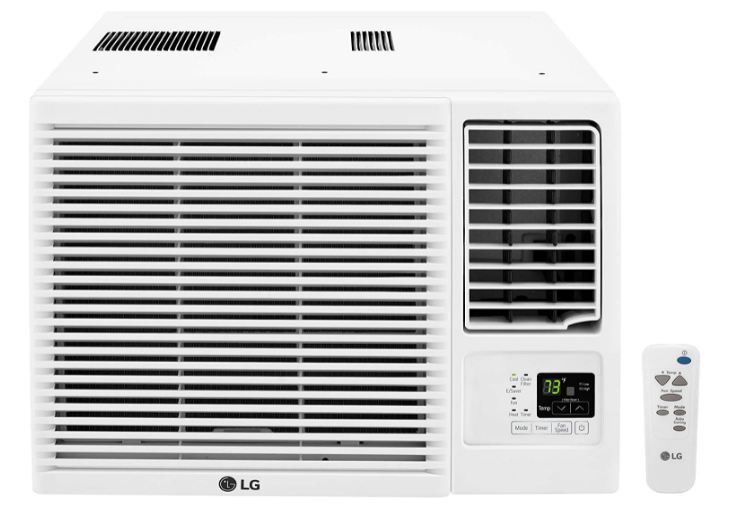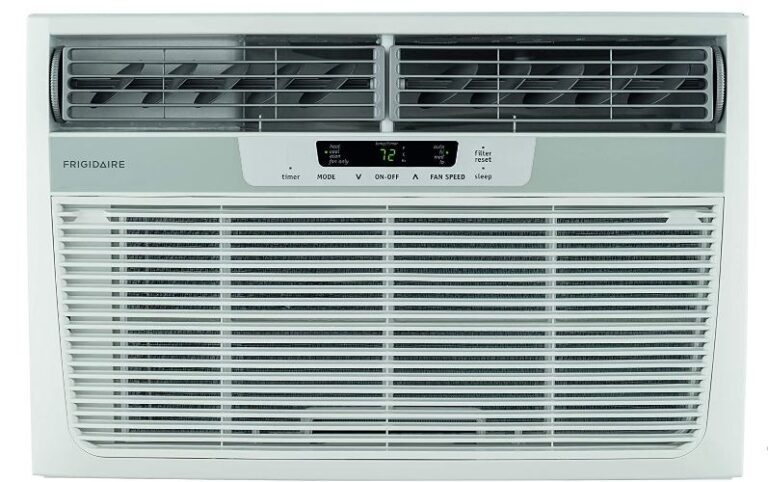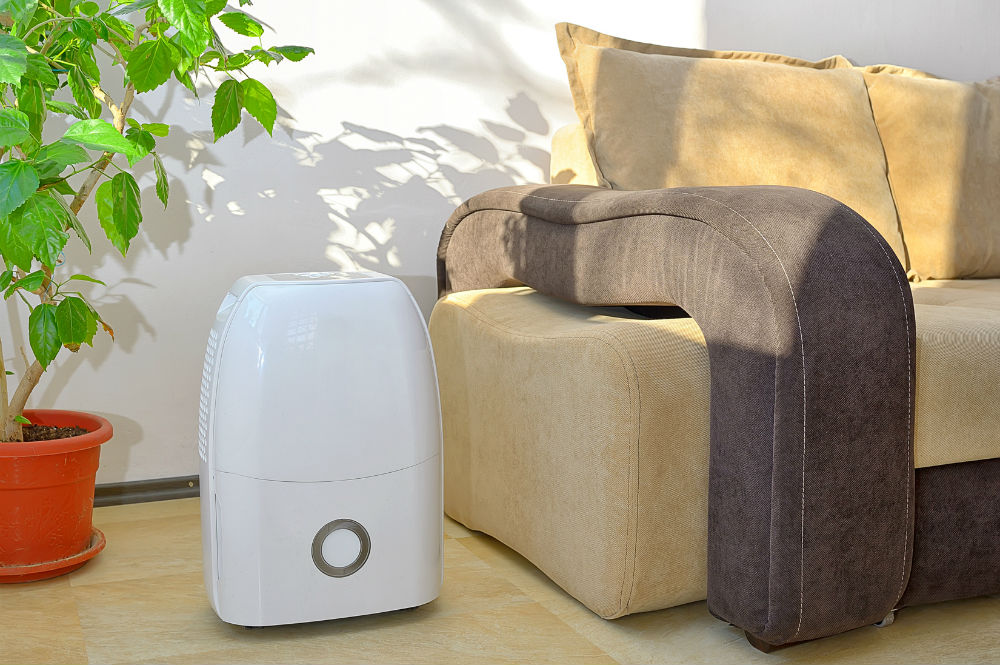Shopping for the best window air conditioner with heat?
You’ve come to the right place.
Using a window air conditioner that can also supply heat is a great one-room HVAC solution for anyone who lives in a northern or subtropical climate.
It’s a great way to economize, too. Instead of buying two devices – an AC and a heater – you can save money and floor space by buying one of the window-mounted units reviewed in this guide.
One word of caution, however: the heaters and heat pumps on these units do not work as well as a conventional heater when temperatures drop below freezing. So keep this in mind.
Still interested?
Here are 3 popular and top-rated units to consider:
Our Top 3 Picks
- 100 sq. ft heating / 350 sq. ft cooling
- 8000 BTU cooling capacity
- 3500 BTU heat pump w/ additional electric heating
- 300 sq. ft heating / 350 sq. ft cooling
- 8000 BTU cooling
- 7000 BTU heat pump w/ supplemental heating
- Dehumidifies 1.5 pints per hour
- 450 sq. ft heating / 550 sq. ft. cooling
- 12,000 BTU cooling
- 11,200 BTU heating
- 2 heating + 2 cooling modes
What's in This Buying Guide
Table of Contents
Picking a window air conditioner with heat isn’t as straightforward as choosing a standard one.
In this guide, we give you all the information you need to select the best heating+cooling window unit for your needs.
First, we review our top picks and discuss their features, benefits, and drawbacks.
Then, we discuss the essential things you should know before buying one including how a heating+cooling air conditioner works, how to install one properly, and how to maintain it.
Finally, we answer common questions related to combination window units.
Best Window Air Conditioners With Heat
- Editor’s Pick: Koldfront WAC8001W
- Most Energy Efficient: LG LW1216HR
- Best for Small Spaces: Frigidaire FFRH0822R1
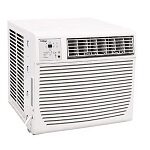
Product
Koldfront WAC8001W (Editor’s Pick)Award
Budget-FriendlyCooling capacity
8,000 BTUHeating capacity
3,500 BTUSupplemental Heat
1320 WRoom Size (Coverage)
350 sq. ft.EnergyEfficiencyRating
10.9Voltage
115 VRemoteControl
YesFanSpeeds
3Cooling Speeds
4AirDirectionControl
4 waysWeight
70.5 lbs
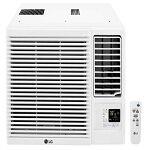
Product
LG LW1216HR (Most Energy Efficient)Award
Energy EfficientCooling capacity
12,000 BTUHeating capacity
11,200 BTUSupplemental Heat
9,200/11,200 BTURoom Size (Coverage)
450-550 sq. ft.EnergyEfficiencyRating
11.3Voltage
230 VRemoteControl
YesFanSpeeds
2Cooling Speeds
2AirDirectionControl
4 waysWeight
93 lbs
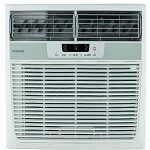
Product
FrigidaireFFRH0822R1 (Best for Small Spaces)Award
Perfect for Small SpacesCooling capacity
8,000 BTUHeating capacity
7000 BTUSupplemental Heat
3500 BTURoom Size (Coverage)
350 sq. Ft.EnergyEfficiencyRating
9.8Voltage
115 VRemoteControl
YesFanSpeeds
3Cooling Speeds
3AirDirectionControl
8 waysWeight
80 lbs
Koldfront WAC8001W might seem a bit outdated in style, but it’s an effective system with great performance.
It has a cooling capacity of 8000 BTU and is ideal for living rooms, bedrooms, and workplaces.
The WAC8001W also features a 3500 BTU heat pump that can warm an average-sized bedroom, home office, or living room.
PROS
- 4-way vents maximize airflow
- Remote control
- Uses a standard 115V outlet
- Check filter light & 24-hour timer
- Energy conservation and sleep modes
- 2-year warranty
CONS
- Older industrial design
Features
- 8000 BTU efficient cooling capacity
- 3500 BTU heat pump with supplemental heating
- 350 sq. ft cooling and 100 sq. ft heating
- Thermostat
- Sleep mode and energy saver mode
- 3 fan speeds + 4 operating modes
- Dehumidifies up to 4.5 pints per day
Our Review
The Koldfront 3500 BTU heater AC unit might not be the best-looking model, but it certainly has features that make it a top choice.
With its 8500 BTU capacity, it can cool rooms up to 350 sq. feet, while its 3500 BTU heating power allows it to serve the same purpose as a single room heater.
Its four directional air flow louvers ensure uniform air circulation throughout the room, along with dehumidification to prevent moisture build-up.
The WAC8001W has an energy efficiency ratio of 10.7, which is above average. The energy-saving mode also contributes to the high efficiency of this unit.
With a single click on the remote control, you can set fan speeds and operating modes according to your preference. The 24-hour timer and sleep mode are thoughtful safety additions.
The check filter light comes in handy to remind you to maintain and clean your AC unit.
The Koldfront WAC8001W runs on a standard 115V/60Hz outlet, making it a good choice for just about any room.
The LG LW1216HR excels in energy-saving and efficiency.
It features a cooling capacity of 12,000 BTU and a heating capacity of 11,200 BTU, which will cover any room up to 550 square feet.
It features symmetrical heating and cooling power, which makes it an excellent replacement for a central unit in a small apartment.
PROS
- Simple remote control
- Perfect for large areas
- Auto-restart function (power surges/outage)
- Energy-saver feature
- Built-in thermostat
- Check filter reminder
CONS
- Limited fan speeds
- Requires 220V outlet
- Expensive
Features
- 12000 BTU cooling / 11,200 BTU heating
- 450 sq. ft heating / 550 sq. ft cooling
- 2 heating and 2 cooling modes
- Highly directional 4-way air louvers
- High energy efficiency ratio (EER) of 11.3
- 5.5 pints/hour dehumidification
Our Review
The LG LW1216HR provides enough cooling and heating capacity to handle the needs of most large rooms and small apartments.
The 12,000 BTU can cool a 550 sq. ft. room, whereas the heating capacity of 11,200 BTU is suitable for up to 450 sq. ft.
The 5.5 pint/hr dehumidifying feature eliminates stale, stuffy air and helps contain mold and mildew.
This window AC has 2 fan speeds, 2 cooling speeds, and 2 heating speeds.
It is perfect for double-hung windows. You also get a slinger fan with this AC.
The exceptionally directional 4-way airflow makes it possible to keep blowing air away from your face and direct it in any direction.
Once the LG LW1216HR reaches the set temperature, the built-in energy saver turns off the fan and heater/compressor.
The auto-restart button helps keep you comfy if the power surges or goes out briefly at night, and the 24-hour timer makes it easy to manage energy consumption while you’re at work.
But perhaps the most attractive feature of this window air conditioner with heat is its high energy efficiency ratio of 11.3, making it one of the most energy-efficient units in its class.
The Frigidaire FFRH0822R1is a compact unit ideal for rooms up to 350 square feet.
Some notable features of the FFRH0822R1 include a strong heat pump providing 7000 BTU of heat and an 8-way directional airflow.
This is a great, energy-efficient, and affordable window air conditioner for just about any small to medium-sized room.
That said, if your interest is heating, be aware that the heater on this unit can only cover smaller rooms up to 150 sq. ft (10’x15′).
PROS
- Filters are easy to clean
- Captures dust
- Full-feature remote
- 24-hour timer and auto-restart
- Works on standard 115V outlet
- Includes mounting kit and chassis
CONS
- Lower than average efficiency @ 9.8 EER
Features
- 8000 BTU cooling (350 sq. ft)
- 7000 BTU heat pump w/ supplemental heat
- Dehumidifies 1.5 pints per hour
- 8-way directional airflow
- 9.8 EER
- 3 cooling + 3 heating modes + 3 fan speeds
Our Review
Boasting an 8,000 BTU cooling effect, the Frigidaire FFRH0822R1 can instantly cool even the hottest rooms up to 350 sq. ft. Meanwhile, its 7000 BTU heating capacity is suitable for areas up to 250 sq. ft.
The 8-way airflow ensures that air is directed wherever needed, regardless of where the device is installed.
The Frigidaire AC dehumidifies the air at 1.5 pints per hour and trap dust particles in the process. This renders the air cleaner, making it a great option for allergic people.
This AC has 3 cold settings, 3 fan speeds, and 3 heat settings.
The 24-hour timer also allows you to keep the room comfortable only when you’re there – to save on electricity.
The only drawback is the relatively low energy efficiency rating of 9.8. Of course, with the 24 hour timer you probably won’t notice the difference.
Buying Guide: How to Choose the Best Window Air Conditioner with Heat?

What is a Window AC with Heat, and How Does It Work?
A window air conditioner with heat is exactly what you think it is – an AC that can also heat the room. It contains all the key components inside the casing, such as the expansion valve, compressor, fan, and controls.
As the name implies, these units are fitted inside a window to dump excess air outside the home while generating cooled or heated air inside the room.
The entire working principle is based on the condenser and evaporator coils, which are critical components to comprehending how a window AC can produce a heating effect too.
In summers, the indoor hot air triggers the thermostat to suck air inside the unit. This hot air is cooled over the condenser coils that lower the air’s temperature and expel it back indoors. The heat is passed on through the refrigerant to the outdoor evaporator coils and hence dissipated.
During the winters, the functioning and direction of airflow are quite the opposite. The indoor condenser coil functions as an evaporator coil, so it sucks in the cool air and heats it. Likewise, the cool air is expelled through the outdoor condenser coil, and the net effect is warmth in the room.
Features
To make sure you invest your money in the right place, it is crucial to take the following features into account:
Heating & Cooling Capacity
This is the basic and most important feature to set your decisions on.
The heating and cooling capacity is measured in BTUs. Higher BTUs have a more powerful effect and are best suited for larger areas, whereas lower BTU ratings indicate that the AC is designed for small spaces.
Based on the area coverage you require, choose a window AC with a powerful heating and cooling capacity to fulfil your requirements. Cooling capacities may range from 8000-25000 BTUs, whereas heating capacities usually range from 3500-16000 BTU.
Room Size (Coverage)
As a general rule of thumb, a typical window air conditioner must feature 20 BTUs per square foot area for proper functioning. This offers an easy calculation for the room size that will suit your AC.
The best window air conditioners are those that can easily cool down and heat bigger spaces.
At the same time, we recommend noting down the ceiling height, window size, and the number of entrances to get a better idea of the most appropriate unit.
Window Type
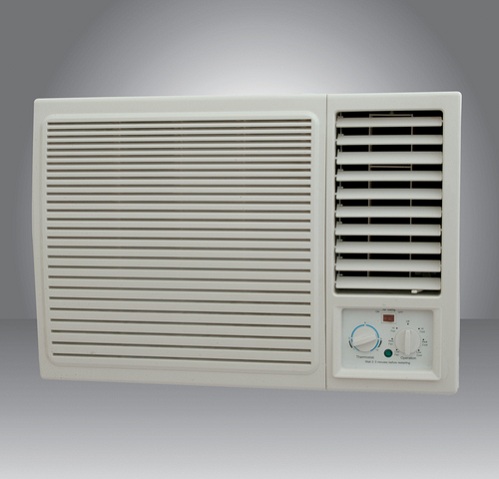
The type of window is a notable feature too. Before choosing an AC, you should make sure that the window measurements comply with the AC dimensions.
It is better to opt for a window in the shade to save energy. The window should also have a suitable electrical connection nearby. Most ACs function on a standard 115V power source, but powerful ones might require up to 230 V.
Energy Star Rating
Window ACs are notorious for a rapid escalation in electricity bills. This all comes down to the energy efficiency ratio (EER), which is based on less consumption of electricity but greater output.
Window air conditioners with an EER of 9 to 10 are considered average efficiency. High-efficiency window air conditioners have an EER of 10 or above.
Remote Control
Ease and convenience are major attractive features in any device. Remote controls are a great way to adjust the temperatures and access various features in the AC. Thus, the entire functioning of the window AC with heat lies in your hand with a click of a button. You won’t even need to move a step!
Adjustable Fan Speed
The actual component that blows cold or hot air into your room is the air conditioner fan. Choose an AC that offers adjustable speed options so that you can regulate the pace of temperature based on your preference.
Most ACs feature 2-3 speed options, ranging from slow, moderate, to high. If you want instant cooling, a high fan speed will get the job done. However, once the desired temperature is attained, you can switch to a slow speed.
Noise Level
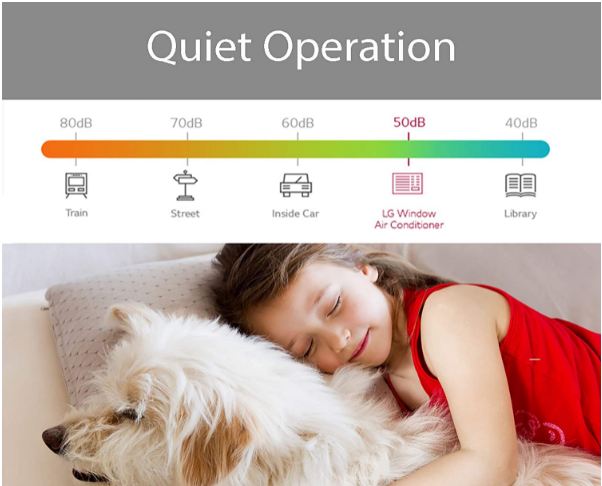
ACs usually have a steady, humming sound that is quite low to be noticed. However, with an increased fan speed, the AC becomes noisier.
The majority of window air conditioners have a decibel rating of 50 to 80. Anything below 60 decibels is considered a quiet window AC, which is what you should aim for if you don’t want any disturbance in your sleep.
Air Direction Control
To maintain a uniform and steady airflow, it is important to have an air direction control feature in your AC unit.
Whether it’s hot air or cold air, adjustable vents can blow air in any direction to target every corner of the room.
Most window air conditioners have a four-way airflow, whereas some feature an 8-directional optimized air control.
Programmable Thermostat
To improve the energy efficiency of your AC, a thermostat helps to pre-set cooling or heating schedules. You can mark your desired temperature on a thermostat to keep the temperatures consistent throughout the day.
The AC will automatically shut off to maintain the selected temperature and save electricity.
Programmable Timer
An inbuilt timer in a window AC is a great feature to minimize energy usage.
Programmable timers allow you to specify a delayed stop or start time based on your routine. They are usually set in 1-hour increments and can last for 12-24 hours.
They also shut down the AC after a specified time in case you forget to.
Filter Alert System
The filter in a window air conditioner is situated within the unit and demands maintenance for good functioning.
A filter alert system will notify you when the filter becomes clogged with dirt. In such cases, you will either need to replace the filters or clean them thoroughly if they are washable.
Warranty
Window ACs are high-power electrical devices that can malfunction anytime. With all the expenses of buying an AC, it would be quite unfair if you don’t get a warranty with your purchase.
With a 1-2-year warranty, you can get help with pre-existing issues if you’ve received a substandard model. Such repairing costs are generally covered by most manufacturers that offer an extended window AC warranty.
Price
Before entering the market, it is recommended to finalize a budget range. Expensive models come with numerous features and higher cooling and heating capacities, while low-end AC units with basic features are better options for smaller spaces.
Choose a window AC with heat that lies in your specified budget.
Durability
Most window air conditioners have a 10-year service life, although this varies, depending on how often you use the device and how well it is maintained.
Since you’re paying a hefty sum in the purchase, it’s good to ensure that the AC is durable and rugged enough to last long through tough times.
Low Maintenance
Although every device requires care, you might not find time for this. Low-maintenance window ACs are a great consideration to get rid of frequent hassles.
Be sure to check how often the filters would need cleaning. Also, it’s better to opt for a slide-out chassis along with the window AC for easy accessibility and maintenance.
Installation of a Window Air Conditioner with Heat
You might want to call in someone for assistance because installing a window AC all by yourself can get overwhelming.
Before you start, you should have screws, brackets, a screwdriver, and a measuring tape. Make sure to choose a window near a power outlet, away from any obstruction.
- Start by marking the center of the window for even placement.
- Open the window and fit in the weatherstrip to block any air gaps that could cause damage.
- Secure the side panels onto the window AC using the screws provided.
- Lift the AC and position it in the center of the window.
- Close the window tightly to secure the AC. If there is a spot where the window panel slides in, then that means you’re doing it right.
- Now secure the AC by screwing the L-brackets to the top of the window. These prevent accidental window opening.
- Fasten the side panels of the AC by extending them to reach the window.
- Use insulating foam strips to fill in any gaps left in the window.
- Plug in the AC to the electrical socket and check if it works correctly. You’re done!
Why Buy a Window AC with Heat over Central HVAC System?
A window AC with heat is a cost-friendly solution to cool and heat a specific room.
If you live in an apartment, a window AC will help you save hundreds of dollars compared to central units. Hence, installing 1-2 window ACs with heat in different rooms will be cheaper in the long run.
For smaller homes, too, window ACs are the best for targeting rooms that remain colder or hotter than the other parts of your house.
Although central HVAC systems tend to be more efficient and target the entire house, a window AC with heat is a better option if you live in a smaller space and are on the lookout for a temporary, budget-friendly solution.
Pros and Cons
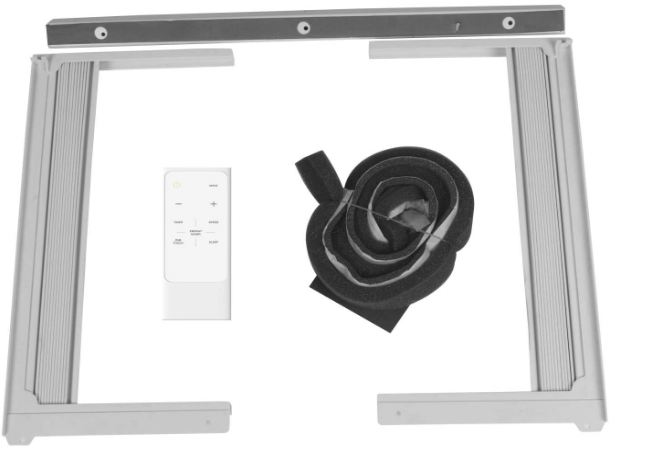
When you’re spending hundreds of dollars on a device that’s meant to keep you comfortable for years, it’s undoubtedly a good idea to know the advantages and disadvantages.
Pros
Dual Function
Being an all-in-one unit, window ACs serve both heating and cooling functions. Most ACs do not come with a heat pump, and it only becomes a hassle to buy a heater separately.
Combo window units allow you to enjoy both cooling and heating environments all year round. With a single investment, you can control the AC to work as a heater in winters and cool down the room in the summers.
Best for Small Spaces
With coverage for an entire room, window air conditioners with heat are a suitable, cost-friendly option for small spaces. They instantly warm-up or cool down rooms, thus eliminating the need for a central system if you’re living in an apartment.
Energy Efficient
In addition to being highly economical and easy to operate all year round, window air conditioners are energy-efficient. They consume less electricity, thus minimizing your overall costs.
To yield maximum efficiency, make sure to choose a window AC based on the room size. A programmable thermostat and energy-saving modes are also thoughtful additions to improve efficacy.
Ease of Use
Another great benefit of window air conditioners with heat is the ease of installation. With a bit of help, you can get the installation done all by yourself.
Gone are the days when window ACs were noisy devices; you can easily find noise-free models now. They ensure quiet working and have notable features like a remote-control easy operation, 24-hour timer, auto-restart functions, etc.
Cons
Not for Large Homes
Window ACs are a better choice for individual rooms, apartments, or small spaces; hence if you want something that works for the entire home, a central system is a better choice.
It would be more expensive to install 4-5 separate window ACs in each room – add to that the electricity costs, and you’re bound to have a tremendous increase in your upfront costs.
Security Risk
There have been many stories of window ACs falling from a height and crashing on the ground. This comes as a huge loss and is particularly life-threatening for anyone walking on the ground.
Window ACs can be removed easily by skillful thieves and robbers to provide an entry into your home, so you must be cautious if you’re going out of town for a few days.
Displeasing Appearance
A major drawback for many homeowners is that window air conditioners take up an entire window of a room and block the outside view permanently.
With an outdated design and limited color schemes, they do not pair up well with the interior décor of most homes.
Cleaning and Maintenance
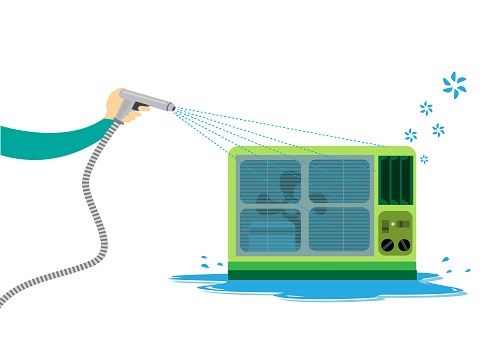
Window air conditioners require regular maintenance to stay in excellent working order. As we continue to use them, dirt and dust collect, potentially obstructing the unit’s efficiency.
For regular cleaning, we recommend washing the filters once a month to prevent clogging. Rinse the filter with warm soapy water, or use a hose if there’s excess dust build-up. Allow the filters to dry completely.
You should replace the filters within three months in case they get damaged.
Make sure to use a fin comb or bristle brush to wipe away debris in the aluminum fins. Go slowly without damaging or bending the fins, and end it by spraying condensed air all over the fins and coils.
Also, remove the casing and wipe the exterior with soap water.
Finish the cleaning process by emptying the drip tray that collects the condensate and cleaning the fan blades with a detergent solution. Allow the AC to dry completely before reassembling its parts.
Frequently Asked Questions
Which is Better: Window Air Conditioner with Heat or Central HVAC System?
There’s no definite answer for this.
If you want something that works for the entire house to keep you comfortable in summers and winters, a central HVAC is worth purchasing. Meanwhile, a window AC with heat is an inexpensive solution if you want cooling and heating in your apartment or in just a single room.
How to Choose the Right Size of Window Air Conditioner with Heat?
To select the right size of a window AC, it is crucial to measure the room coverage, sunshine exposure, and the number of persons in the room.
5000-8000 BTU is suitable for rooms up to 350 sq. ft., whereas, for larger areas up to 550 sq. ft, an air conditioner around 12000 BTU is sufficient.
What Is the Smallest Window Air Conditioner with Heat?
The smallest window AC with heat currently available in the market has a capacity of 5000-5200 BTU capacity and is suitable for spaces measuring 100-250 square feet. LG and Friedrich are notable brands that manufacture small window ACs with heat.
Final Verdict: What is the best window air conditioner with heat sold today?
I’m a degreed ME (mechanical engineer) who is passionate about machines of all kinds. I created MachineWonders.com as a way to connect with others who love machines like me – or need help choosing one for their needs, application, or situation.

